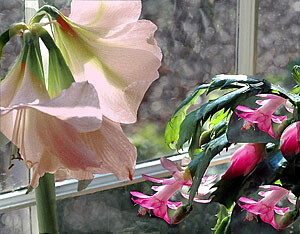The robust, colorful blooms of an amaryllis or a Christmas cactus, dripping with red, pink, salmon or white blossoms, enhance the holiday season with cheer and beauty. With appropriate care, these favorites will give stunning repeat performances for many years.

With large, bell-shaped flowers, the amaryllis makes a bold and elegant statement. Each sturdy stalk may produce up to four large blooms in red, salmon, pink, white, or combination colors, depending upon the variety.
The potted amaryllis should be placed where it will receive four hours of sunlight daily. Normal home temperature of 65-75 degrees will encourage more bloom, but flowers last longer if home temperatures stay five degrees cooler.
As flowers increase, water the amaryllis more frequently. Allow the soil surface, though, to become slightly dry to the touch before watering. Fertilizing during the bloom period is not necessary. With care, the amaryllis will bloom for three weeks.
When blooms have finished, cut the stalk-like flower stems back to two inches above the bulb. Continue to water, allowing the strap-like leaves to continue to grow, ensuring that necessary energy will be stored in the bulb.
In mid- spring move the amaryllis pot to a shady area outside. Eventually move it to where it will get good morning sun. Because the amaryllis bulb enjoys crowded conditions, just leave the amaryllis in the same pot. Provide water and fertilizer throughout the summer months. In September, bring the pot inside and place in a cool room. The amaryllis must then rest, without water or fertilizer, in order to rebloom indoors again.
After the rest period, amaryllis leaves should be cut off. Home gardeners may choose to repot the bulb or leave it in the original pot. Begin watering and fertilizing in late November and move the pot to a sunny, warm location. Flower stalks will appear first, followed by amazing blooms during the Christmas season.
Amaryllis will do well outdoors, also. In spring, plant the bulb outside in a sunny or partly sunny area in well-drained soil. Only the tiniest tip of the bulb should show above ground. With the right conditions, the bold blooms should appear the following spring and for many springs to come.
Christmas cactus, another beautiful holiday favorite, will provide longer-lasting blooms when placed in indirect, but bright light, at home temperature of 65-75 degrees. Place this tropical away from drafts and heating vents to avoid bud drop that often occurs with extreme temperature changes. Remove spent blooms, and keep the cactus slightly moist to the touch. Make sure the cactus does not sit in water.
After blooms have finished, move the cactus to a sunny window and water only moderately. Fertilize with a regular houseplant solution. To encourage branching, prune by pinching off a few sections of each stem. The segments removed may be rooted very easily in water or in moist vermiculite.
In late spring, the Christmas cactus will enjoy a semi-shady site outside. Because this tropical plant sunburns easily, keep it out of direct sun. Continue to water and fertilize. Before frost, bring the cactus inside into a cool room. In early December move the cactus to a sunnier and somewhat warmer location. By Christmas, the cactus leaves will produce a cascade of color.